When it comes to big spends, I’m not so much a dip-a-toe-in-the-water kind of person as a still-standing-on-the-beach-wearing-shoes sort. I procrastinate a fair bit; something that is exacerbated in this instance by the type of caravan I’m after.
You see, I don’t want a brand-new one. The modern ‘van with its double-glazed weathertight windows and stacked, sumptuous interior’ isn’t for me.
Rose-Tinted
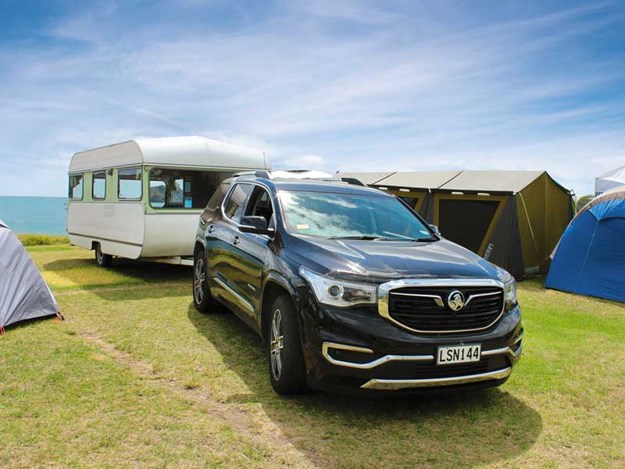 |
The gutsy Holden Acadia LTZ-V makes towing uphill a breeze |
What I’m after is a Kiwi icon rendered in the bright hues of the 1970s; a Lightweight or a Classic or a Nomad, with a stripy awning and a fold-out table featuring a careworn surface dulled by years of sun and scratched from a million rounds of Last Card or Cluedo.
Chequerboard lino underfoot? Even better. When you’re knee-deep in the second-hand market, there is a lot to look for – and look out for.
It doesn’t matter what build quality template the caravan adhered to when it emerged from the factory; a ’76 Anglo that has lived its life at one end of the country might be in a completely different state from its identical twin somewhere else.
Environments holidayed in, miles covered, inside or outside storage in the off-seasons and even how many Marmite-smeared sprogs regularly attempted to pull the thing to bits every summer all serve to ensure no two old caravans remain the same.
A year or so of faithfully adding examples to my auction website’s watch-list has also taught me that all the ‘good ones’ appear to be at the other end of New Zealand from where I reside.
Without the wherewithal to fly up and down the country for a look every time a half-decent Classic appears online, that’s a tad frustrating. But also another matter for another day.
Try before you buy
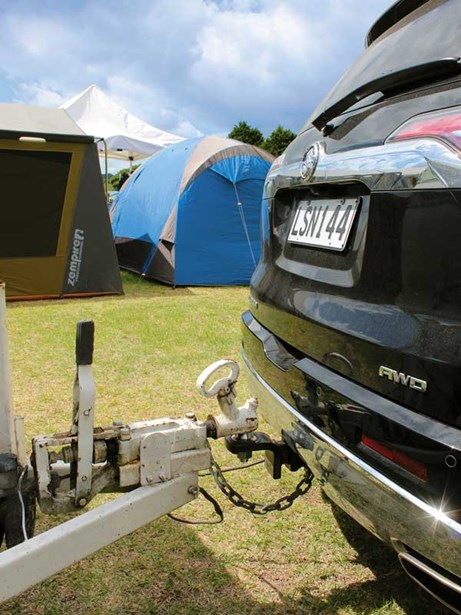 |
Holden’s Hitch Guidance system simplifies the task of hooking up to the caravan |
So, with the summer holidays approaching and my mind (and budget) firmly set on an older van – but without wishing to take the plunge on the first warrantable thing that comes along – what to do?
Closer inspection of a few caravan sales yards revealed that some also have small hire fleets. These will generally be made up of older vans of varying sizes (the larger the van, the more likely it is probably destined for longer-term hire) and almost exclusively of 1960s, ‘70s and possibly ‘80s vintage.
If you’re expecting the Taj Mahal, consider a different option. By and large these hire fleets feature caravans which are a bit frayed around the edges. No, they’re not dirty; in fact, our one was spotlessly clean as far as surfaces and squabs went.
But they are old, basic and have led relatively demanding lives. They probably won’t feature onboard bathroom facilities either, although this didn’t concern us as we’re firmly campground folk.
Hire vans will arrive with all the relevant certifications and a lead for powered sites, but aside from things like a spare wheel and wheel jack, blocks to help get it level, a small fridge and perhaps a dustpan and brush under the sink, you’ll be BYO-ing everything.
We paid a deposit a few months out from our hire dates (a limited supply of hire vans in the popular summer months means you might need to consider booking well ahead of time), with the balance and a $1000 refundable bond paid when we collected our retro home-away-from-home.
Logistics, logistics
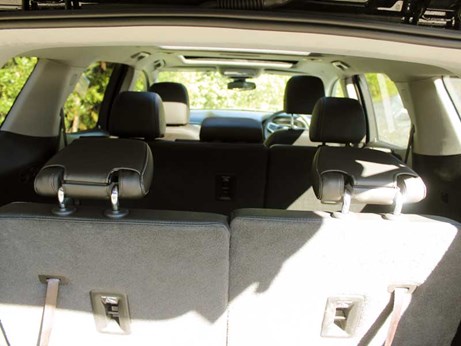 |
The Acadia has seven full-sized seats |
I opted to book something from a hire yard part-way between home and our regular holiday haunt in the Far North, figuring that collecting the van on the way would be easier than making a special trip out to the yard and returning home with it beforehand.
This decision had its pros and cons. The main positive – and I admit this one is very specific to your present correspondent – is that we live on a steep section formed across four flat terraces carved out of the hillside, one of which is a parking pad.
Job number one on the pre-caravan purchase ‘to do’ list is making that parking pad bigger, so as to accommodate a big retro box alongside the two vehicles already parked there. Yes, you read that right: I can’t technically fit a caravan on my section.
Yet. Not fancying the idea of having a caravan sitting on the tow ball of my tow vehicle – and on a downward sloping driveway – all night before departure (let alone the precipitous act of trying to load a caravan with sleeping bags and food items on an angle), the hire booking was timed to perfection for Day One of our holiday.
Except that it wasn’t all perfection. This plan did mean a bit of a re-pack was required when we reached the hire yard, as we carefully loaded a few of the more cumbersome items that had been crowding the car into the caravan after uplifting the keys; most notably mountain bikes, which we really hadn’t factored into the equation for the home-to-hire yard section of the journey.
Much to the relief of our backseat passengers (who travelled the first 20km or so with bike wheels hovering above their heads and handlebars tickling their ears), these were secured inside the van with bungee cords for the remainder of the trip north.
Naturally, we had to reverse engineer this (small) fiasco on the homeward leg too, stuffing bikes, bags of sandy beach towels and the smallest child’s “highly valuable” shell collection back into the car upon returning the caravan.
Retro tow? No!
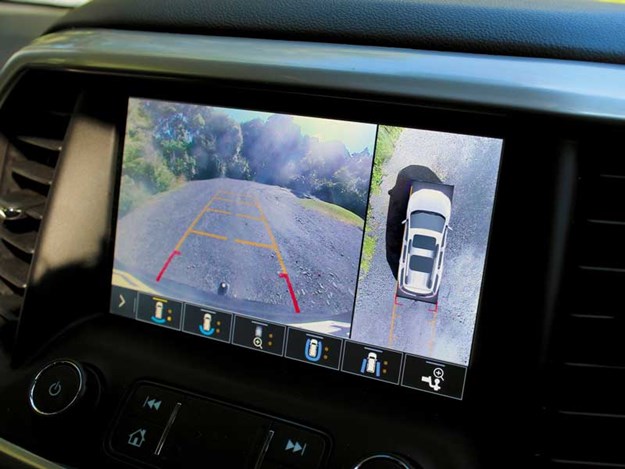 |
Bird’s eye view tech gives you a clear snapshot of your position |
Now, while the temptation was there to pair my old hire van with a period-correct tow vehicle (come on, how awesome would she have looked being towed by a matching mint green Valiant Regal or Land Rover 110 for example?), I opted for some modern firepower instead.
Holden New Zealand loaned me a brand-new Acadia LTZ-V for the occasion. Released onto the Kiwi market at the end of last year, the Acadia is Holden’s second largest SUV (after the Colorado-based Trailblazer) and the first to be sourced from another part of the General Motors universe, GMC.
New Zealand market Acadias come fully-loaded with an enviable selection of standard equipment, including Apple CarPlay, wireless phone charging (for compatible smartphones), seven full-sized seats and a heap of safety spec, such as Lane Keep Assist and Autonomous Emergency Braking.
For me, the added bonus here is Holden’s Hitch Guidance system, which gives you a handy centre line when you’re backing up to a caravan or trailer.
Then, utilising clever ‘bird’s eye view’ technology, you can see the car and caravan combo from above, which is handy when manoeuvring around a busy campsite.
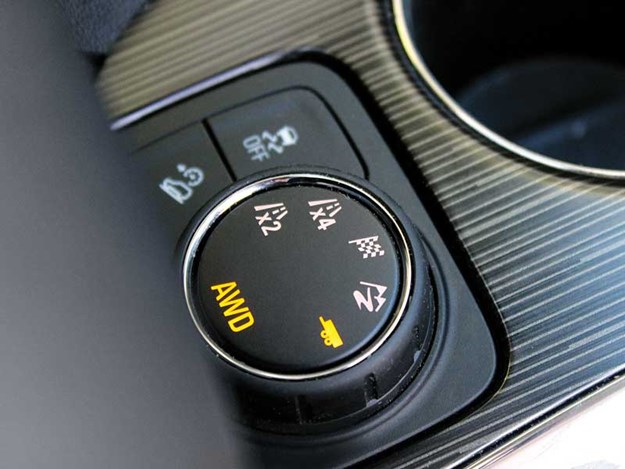 |
The Acadia’s Drive Mode selector dial allows quick and easy selection of two- or four-wheel drive |
You can also check on the tow ball with a downward-facing camera view mid-tow for added peace of mind on the road. A specific ‘Haul Mode’ shifts the gearing to suit a load on the back too, so you’re never over-straining the transmission.
Power comes courtesy of a gutsy 3.6-litre V6, driven through a nine-speed automatic transmission. My van of choice was hardly a beast, but I never felt like I was being pushed around on the very twisty back roads required to get to our campsite.
The Acadia remained composed and never short of puff, regardless of the terrain. The dreaded climb up the Brynderwyns north of Auckland with the caravan on the back was executed with grace and road-legal pace.
All that clever tow tech presented me with a nice surprise at the end of the trip too: combined average fuel economy was just shy of 12 litres/100km.
I certainly wasn’t expecting that from a big petrol V6 hauling a caravan up and down the hills of Northland. But the Acadia proved an absolute winner; money saved back into the caravan kitty.
Conclusion
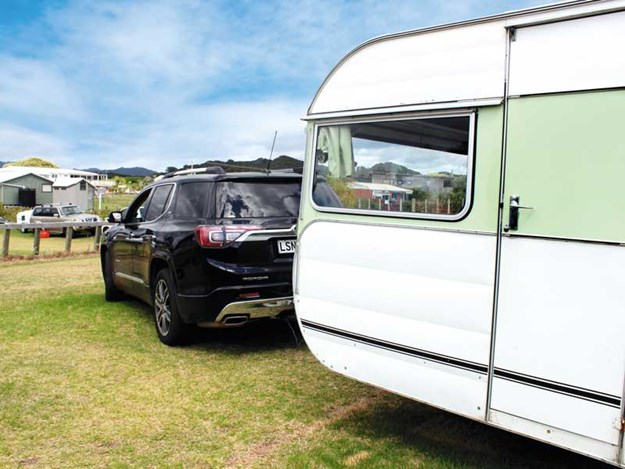 |
A hi-tech Holden and retro charm – the perfect combo |
Hiring an older caravan not only provided a great option for our most recent holiday, but it served as something of a test-run ahead of making the leap into actual ownership.
It gave us strong clues in terms of what to look for as far as 1970s-era wear and tear goes, whether our expectations match our budget and what it might take to refurb a 45-year-old caravan for semi-regular use.
It helped us establish how big any van will need to be to successfully accommodate the whole family, what internal configuration will work best and whether an awning is a must-have or just a bonus.
On the periphery (but of no less importance), hiring also gave us an inkling of what sort of tow wagon we’ll need to comfortably lug our dream caravan from point A to B and just how much space we’ll have at our disposal in order to store it on our section when it isn’t being used.
Or, at the very least, how much we’ll have to budget for if the right van appeared at the wrong time and we needed to utilise space in a storage yard until we finish landscaping the desired spot on our section.
With the glorious summer the country has enjoyed this year rapidly disappearing in the rear view, there might be a few more caravans on the market in the coming couple of months as people weigh up what’s ahead on the work and recreation front for 2019. I’d better get back to that auction website…





